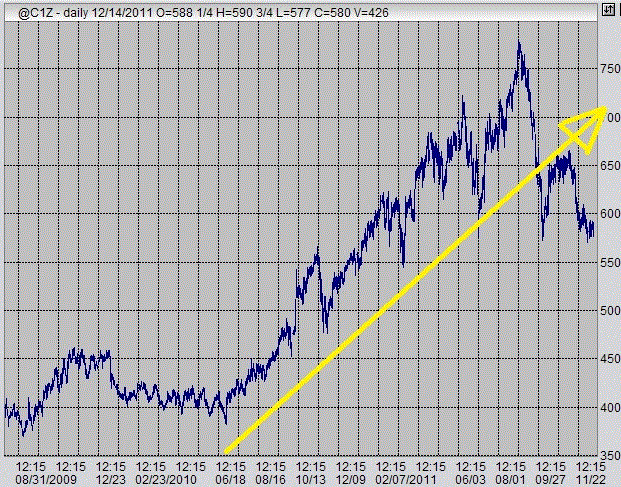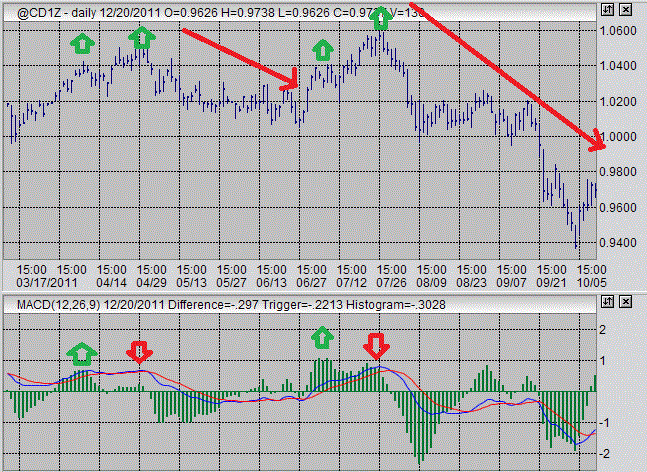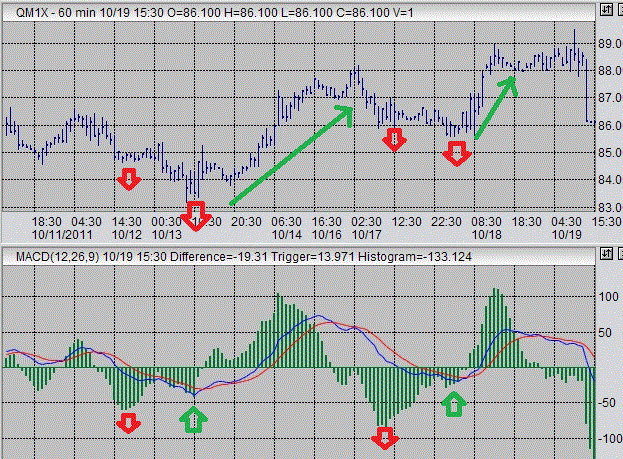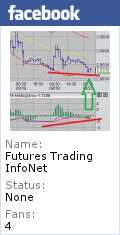Use this search feature to quickly find the information you're looking for.
Trading System: MACD Divergence
The trading system that is described here is an MACD divergence trading strategy. It is one of many day trading strategies, or longer term strategies, that can be applied to trading crude oil futures, trading currency futures, or any other type of futures trading in almost any time frame. It is also my favorite trading system.
In trading equity products and their derivatives like stocks and futures it is important, as with all things, to have strategy and tools.
There are two basic schools of thought for predicting a security’s upcoming price direction: fundamental analysis and technical analysis. Fundamental analysis consists mainly of identifying market moving forces like supply and demand, news, weather (for agricultural commodities), the May long weekend (for gasoline futures), and so forth.
Technical analysis consists mainly of looking at price charts and deducing by recent price movements that some people know more than others and their knowledge is reflected in the subtle movements of price. The idea with technical analysis is to catch the prevalent mood and hop along for a hopefully profitable ride.
In technical analysis it is important to be able to identify the underlying trend in price of a product or security. The trend is the general direction of price movement. Trading in the same direction of a trend was well put by famous trader Jesse Livermore as being “the path of least resistance”. It can be particularly advantageous to be able to identify the beginning, end, or reversal of a trend. This page will describe a tool known as the MACD divergence and demonstrate that using it can produce a very strong signal of trend reversal.
When trading financial products such as stocks or derivatives it is beneficial to trade with the trend, whether it is during an existing trend or at a point of reversal. “A trend can be defined as the general direction of a market or of the price of an asset. Trends can vary in length from short, to intermediate, to long term”.
Trends are characterized by prices making consecutively higher highs and higher lows in an uptrend, or lower lows and lower highs in a downtrend. An example of the potential profit available by identifying a trend early is in that of corn futures between July 2010, and June 2011 which trended upward from a price of roughly $4 per bushel to nearly $8 per bushel as seen in the following futures trading chart in which the trend is identified by a large yellow arrow.

This trend movement is equivalent roughly to a $16,000 change in value per contract traded. Corn futures trading volume is in the range of 50,000 or more contracts daily. Identifying a trend reversal can be a productive way of getting in on the ground floor of a trend.
Investopedia defines a trend reversal as “a change in the direction of a price trend”. A common indicator used to gauge the momentum of a current trend or to identify a trend reversal is the moving average convergence-divergence (MACD) and its histogram, usually displayed at the bottom of a price chart.
I find an excellent wording to describe what the MACD histogram does is “[momentum rises or wanes] if as prices are rising, the histogram grows larger as the speed of the price movement accelerates, and contracts as price movements decelerate. The same principle works in reverse as prices are falling”. The visual representation of MACD is two lines moving above and below a central horizontal line, and its histogram by bars coming off below and above the same line.
The trading signal in question is the MACD divergence as compared to price movement. It is demonstrated when the MACD or its histogram increases or decreases contrary to the increasing or decreasing price of the security in question while price traces two or more prominent new lows or highs for the time period.
Excellent wording of the phenomenon by a psychiatrist author specializing in trading is “A divergence occurs when the trend of price highs and lows goes one way and the trend of tops and bottoms in MACD-Histogram goes the opposite way” (Elder, 2002).
The MACD histogram is shown by pink bars in the examples to follow. An important detail to watch for when identifying this phenomenon is whether or not the MACD lines touch down or briefly cross with the central horizontal line in between the lows or highs as doing so adds strength to the signal, as will be shown with the 10-year US Treasury notes.
The way to trade the MACD histogram divergence is if prices make two consecutive new lows but the MACD histogram’s corresponding second low is notably higher than the first, then one has a divergence giving a bullish signal.
Conversely, if prices make two consecutive new highs and the second MACD histogram high is lower than the first this indicates a bearish signal.
The idea behind this signal is that if prices make new highs but the MACD histogram does not, then the momentum of the trend is running out and prices are due for a change. The change can be a major trend reversal or just a correction of varying size and length.
It is important to note that the two consecutive new highs or lows are not immediately consecutive from one price bar to the next, but rather consecutive within a general time frame. You have to get experience to recognize when this is occurring.
This indicator can be applied to a variety of time frames, so it is difficult to generalize exactly how much time in between highs or lows must be allowed.
An example of a MACD histogram divergence trading system is illustrated in the next chart for US Dollar Index futures. The consecutive price lows around 74.00 are marked by two red arrows and the negatively diverging MACD histogram lows are marked by a red and then a green arrow.
The new trend are marked by the larger green and arrow. This particular MACD histogram divergence signal indicated a change to a bullish posture, a signal to go long, or to expect a rise in prices. The uptrend following the signal could have provided a maximum of $6000 in profits per contract traded. It is then followed by a second MACD histogram divergence signal.
The second signal is marked by three green ascending green arrows which correspond with three MACD histogram arrows on descending peaks.
The bearish trend they signal is shown with a large red arrow. This signal could have provided a profit of $5000. Is this trading system appealing yet?
To demonstrate that the MACD histogram divergence signals in the US Dollar Index chart were not isolated incidents, here are a more examples of this phenomenon in the recent price history of some prominent financial markets.
The chart below demonstrates the beginning of two downtrends in the value of the Canadian dollar against the US dollar. This is an excellent example of trading currency futures. In this first downtrend, the two consecutive highs in price are marked by two small green arrows and the negatively diverging MACD histogram highs are marked by small green and red arrows.
This particular signal foretold a downtrend. The signal was, in fact, followed by a two-month long downtrend indicated with a large red arrow. The two month downtrend could have been good for a maximum of around $4,000 in profit per contract traded.
In the second bear signal using the trading system, the higher highs are marked by two green arrows and the diverging MACD histogram highs are marked by a green and then a red arrow. The Large red arrow indicates the two and a half month trend that could have provided a $12,000 profit. Entry should have occurred on where the smaller red arrows mark the MACD divergence.
Is this trading system appealing yet?

Another example of the MACD histogram divergence phenomenon is demonstrated in the next several examples with light sweet crude oil futures prices in a 60 minute time frame.
Twice in a row, the consecutively increasing price highs are marked by two small green arrows and the negatively diverging MACD histogram highs are marked by one small green arrow and a small red arrow in both cases. The changing price trends are marked by large red arrows.
These downtrends could have provided a maximum of $2000 and $3000 in profit per contract traded. This would have proven to be a very profitable way of trading crude oil futures. Are you getting comfortable with this trading system?
The following example uses the exact same 60 min crude oil chart as above. The difference is that here we will show how a long position can be used to take profits at the same time that you are taking advantage of the shorting opportunities(not the exact same time, but close).
Again, there are two examples that occur in a row. The lower price lows are marked by red arrows, and the corresponding MACD histogram divergence is marked by a red and then a green arrow. The large green arrows mark the trend that would have provided you profits of roughly $4000 and $3000.
Be sure to look at the time/date data in the chart to be aware of the time frame it would have taken to make these trades.
Are you familiar with this trading system and how it can be applied to trading futures?

The MACD and its histogram histogram has been described and its proper use demonstrated. The price chart examples of the Canadian dollar, US Dollar Index, and light sweet crude oil all demonstrate trend reversals that were accurately predicted by the MACD histogram divergence signal.
Handsome profits were available had a trader put on a position corresponding to the indications of the tool in question. The prominence of all three markets and the relative recentness of the phenomenon indicate that this is not an obscure situation, but rather something that happens with frequency in major markets.
The MACD divergence can also function as one of many effective day trading strategies. One important fact remains. However good this tool may be, financial markets are volatile and unpredictable. If one chooses to trade using tools such as the MACD histogram divergence, one must accept the fact that not all MACD histogram divergences result in a change in trend, and, if they do, it will not always be a profitable trend reversal.
Because of these uncertainties, a trader must invigilate trades and use safety measures like stop-loss orders in case prices move against a trade in place.
Becoming proficient in the MACD divergence trading system can be very rewarding, both economically and for one's sense of accomplishment. This trading system can be applied in a variety of time frames in a variety of markets. A lot of people have indicated (like Alexander Elder, and Gerald Appel) that this is one of the most reliable trading systems of all. However, as we all have different personalities, be sure to learn about other trading systems to find the one that best suits you.
Ads:
Learn more about the MACD trading system.
Go from here Trading System: MACD Divergence to the Futures Trading InfoNet Home Page






New! Comments